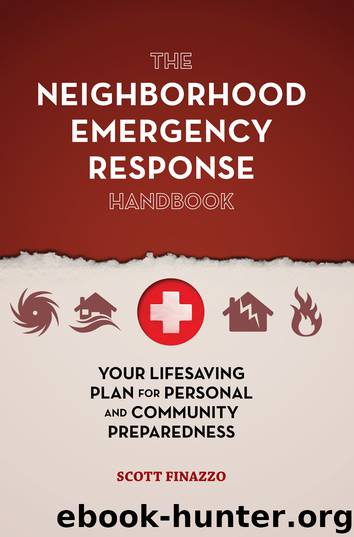The Neighborhood Emergency Response Handbook by Scott Finazzo

Author:Scott Finazzo [Finazzo, Scott]
Language: eng
Format: epub
ISBN: 9781612434605
Publisher: Ulysses Press
S.T.A.R.T. METHOD
Several methods are used to prioritize victims. Many professional emergency responders manage multiple casualty incidents using START triage: simple treatment and rapid transport. The START method utilizes color codes to quickly sort victims based on how they present to the rescuer. The color codes are:
Green: Minor Injuries
The walking wounded that self-evacuate are typically “green” patients. They will require little from you and can often treat themselves. Often, they will flee the scene altogether. With those that haven’t fled, you can “voice triage.” Call out to them and find to find out their status and the status of others. Verbally direct them. You may attempt to keep them around to assist you if their injuries allow. If not, do not encourage them to wander aimlessly around the scene. Relocate them to an area of refuge, protected from the weather, where they can receive treatment and recover.
Examples of “green” injuries are minor lacerations, sprains, bruises, and superficial burns.
Yellow: Delayed Treatment
If patients are triaged “yellow” or “delayed,” it does not mean they are not injured. It means that, based on what you have observed, they are not at a high risk for early death and you can continue to assess other patients.
Examples of “yellow” injuries are fractures, moderate burns (that do not include the face, neck, or groin), and lacerations that have not cut into an artery.
Red: Immediate Treatment
The primary goal of sorting and prioritizing patients is to locate and help the “red” patients. Those are the people with potentially life-threatening injuries. One of the most difficult parts of the triage process is identifying the injured and moving on to the next. If you encounter a red victim and their injuries include an airway issue, you may reposition the airway (see Chapter 6). Otherwise, MOVE ON. Remember, you are doing the greatest good for the greatest number of people.
Examples of “red” injures are significant burns (especially to the face or neck), sucking chest wounds (a collection of air in the chest which causes part or all of a lung to collapse), shock, and severe external hemorrhages.
The sad reality is that there is no cardiopulmonary resuscitation (CPR) in a disaster. Even professional emergency responders will bypass CPR when the needs of victims outnumbers those that are able to offer aid. If someone is not breathing and/or their heart is not beating, they are considered deceased or type “black.” Unfortunately, the time and resources to focus the type of attention required for someone who is in need of CPR are lacking. In a mass casualty environment, CPR is rarely effective and keeps rescuers from tending to potentially savable patients.
Black: Deceased
When you encounter a victim that is not breathing, you can try to reposition the airway by placing the person on their back and tilting their head up. If there are no respirations, attempt to reposition the airway one more time. If there is no spontaneous return of respirations, you must consider the person deceased. Leave them where they lie and mark them as deceased,
Download
This site does not store any files on its server. We only index and link to content provided by other sites. Please contact the content providers to delete copyright contents if any and email us, we'll remove relevant links or contents immediately.
SAS Survival Handbook by John 'Lofty' Wiseman(2630)
Food and Water in an Emergency by Food & Water In An Emergency(2301)
Dangerous Personalities by Joe Navarro(2203)
Sea Survival Handbook by Keith Colwell(2076)
The Survival Medicine Handbook: A guide for when help is NOT on the way by Joseph Alton & Amy Alton(1763)
First Aid Handbook--Crucial Survival Skills, Emergency Procedures & Lifesaving Medical Information by Department of the Army(1760)
100 Skills You'll Need for the End of the World (as We Know It) by Ana Maria Spagna(1633)
Sheep No More by Jonathan T. Gilliam(1587)
The Survival Savvy Family by Julie Sczerbinski(1582)
TWA 800 by Jack Cashill(1562)
Prepper's Survival Medicine Handbook: A Lifesaving Collection of Emergency Procedures from U.S. Army Field Manuals by Scott Finazzo(1550)
Spy Secrets That Can Save Your Life: A Former CIA Officer Reveals Safety and Survival Techniques to Keep You and Your Family Protected by Jason Hanson(1499)
The Complete U.S. Army Survival Guide to Foraging Skills, Tactics, and Techniques by Jay McCullough(1449)
The Emergency Survival Manual by Joseph Pred(1406)
Be a Hero by John Geddes(1378)
The Natural First Aid Handbook by Brigitte Mars(1352)
Joey Green's Magic Health Remedies by Joey Green(1285)
The Zombie Survival Guide by Max Brooks(1245)
First Aid for Colleges and Universities (10th Edition) by Mistovich Joseph J. & Limmer Daniel J. & Karren Keith J. & Hafen Brent Q(1209)
